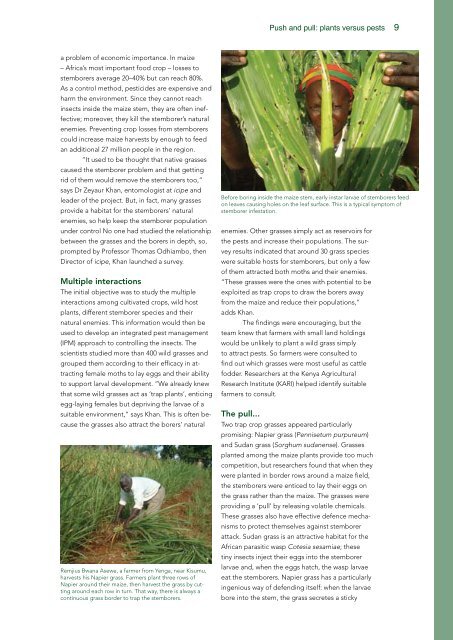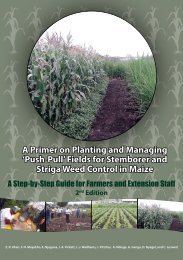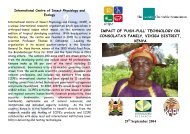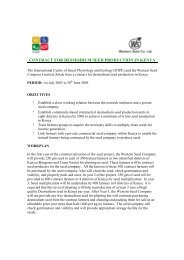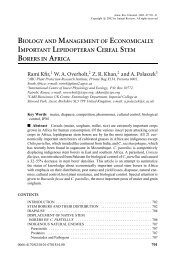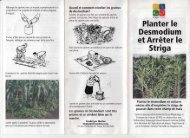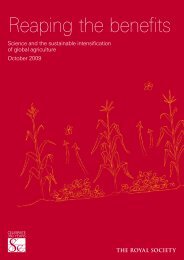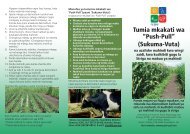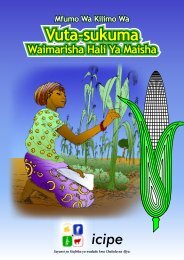a model for Africa's green revolution - Push-Pull
a model for Africa's green revolution - Push-Pull
a model for Africa's green revolution - Push-Pull
You also want an ePaper? Increase the reach of your titles
YUMPU automatically turns print PDFs into web optimized ePapers that Google loves.
<strong>Push</strong> and pull: plants versus pests 9<br />
a problem of economic importance. In maize<br />
– Africa’s most important food crop – losses to<br />
stemborers average 20–40% but can reach 80%.<br />
As a control method, pesticides are expensive and<br />
harm the environment. Since they cannot reach<br />
insects inside the maize stem, they are often ineffective;<br />
moreover, they kill the stemborer’s natural<br />
enemies. Preventing crop losses from stemborers<br />
could increase maize harvests by enough to feed<br />
an additional 27 million people in the region.<br />
“It used to be thought that native grasses<br />
caused the stemborer problem and that getting<br />
rid of them would remove the stemborers too,”<br />
says Dr Zeyaur Khan, entomologist at icipe and<br />
leader of the project. But, in fact, many grasses<br />
provide a habitat <strong>for</strong> the stemborers’ natural<br />
enemies, so help keep the stemborer population<br />
under control No one had studied the relationship<br />
between the grasses and the borers in depth, so,<br />
prompted by Professor Thomas Odhiambo, then<br />
Director of icipe, Khan launched a survey.<br />
Multiple interactions<br />
The initial objective was to study the multiple<br />
interactions among cultivated crops, wild host<br />
plants, different stemborer species and their<br />
natural enemies. This in<strong>for</strong>mation would then be<br />
used to develop an integrated pest management<br />
(IPM) approach to controlling the insects. The<br />
scientists studied more than 400 wild grasses and<br />
grouped them according to their efficacy in attracting<br />
female moths to lay eggs and their ability<br />
to support larval development. “We already knew<br />
that some wild grasses act as ‘trap plants’, enticing<br />
egg-laying females but depriving the larvae of a<br />
suitable environment,” says Khan. This is often because<br />
the grasses also attract the borers’ natural<br />
Remjius Bwana Asewe, a farmer from Yenga, near Kisumu,<br />
harvests his Napier grass. Farmers plant three rows of<br />
Napier around their maize, then harvest the grass by cutting<br />
around each row in turn. That way, there is always a<br />
continuous grass border to trap the stemborers.<br />
Be<strong>for</strong>e boring inside the maize stem, early instar larvae of stemborers feed<br />
on leaves causing holes on the leaf surface. This is a typical symptom of<br />
stemborer infestation.<br />
enemies. Other grasses simply act as reservoirs <strong>for</strong><br />
the pests and increase their populations. The survey<br />
results indicated that around 30 grass species<br />
were suitable hosts <strong>for</strong> stemborers, but only a few<br />
of them attracted both moths and their enemies.<br />
“These grasses were the ones with potential to be<br />
exploited as trap crops to draw the borers away<br />
from the maize and reduce their populations,”<br />
adds Khan.<br />
The findings were encouraging, but the<br />
team knew that farmers with small land holdings<br />
would be unlikely to plant a wild grass simply<br />
to attract pests. So farmers were consulted to<br />
find out which grasses were most useful as cattle<br />
fodder. Researchers at the Kenya Agricultural<br />
Research Institute (KARI) helped identify suitable<br />
farmers to consult.<br />
The pull...<br />
Two trap crop grasses appeared particularly<br />
promising: Napier grass (Pennisetum purpureum)<br />
and Sudan grass (Sorghum sudanense). Grasses<br />
planted among the maize plants provide too much<br />
competition, but researchers found that when they<br />
were planted in border rows around a maize field,<br />
the stemborers were enticed to lay their eggs on<br />
the grass rather than the maize. The grasses were<br />
providing a ‘pull’ by releasing volatile chemicals.<br />
These grasses also have effective defence mechanisms<br />
to protect themselves against stemborer<br />
attack. Sudan grass is an attractive habitat <strong>for</strong> the<br />
African parasitic wasp Cotesia sesamiae; these<br />
tiny insects inject their eggs into the stemborer<br />
larvae and, when the eggs hatch, the wasp larvae<br />
eat the stemborers. Napier grass has a particularly<br />
ingenious way of defending itself: when the larvae<br />
bore into the stem, the grass secretes a sticky


